Life Expectancy
Life Expectancy
Life Expectancy
-
 Life Expectancy: information on life expectancy in Bury including inequalities by sex, deprivation and geography.
Life Expectancy: information on life expectancy in Bury including inequalities by sex, deprivation and geography.
Life Expectancy
In the decades up to 2011, life expectancy increased steadily in England. Infectious-disease related deaths were common in the last century and were often preceded by a brief period of illness. Chronic non-communicable diseases are now the leading causes of mortality and are often preceded by long periods of severe to moderate illness prior to death.
Life expectancy (LE) and health life expectancy (HLE) are two important indicators that provide valuable insight into the health of a population. Life expectancy is the average number of years a person is expected to live and is a useful indicator of the overall health of a population. Life expectancy can be influenced by a variety of factors, including access to healthcare, behavioural risk factor, sex, race, and the environment.
In contrast, healthy life expectancy considers the quality of life in addition to the length of life. It is defined as the number of years a person is expected to live in good health, without significant disability or disease. This indicator can provide more information about the health status of a population and help identify areas where interventions are required to improve health outcomes overall (HM Government, 2017).
Life expectancy at birth
Life expectancy at birth is a statistical measure that estimates the average number of years a newborn is expected to live based on current mortality rates. Life expectancy at birth considers mortality rates at each age from birth to the end of a person's life.
Examining data for Bury, LE for both males and females have increased over the past two decade, however females have consistently higher life expectancy than males throughout the years from 2001 to 2020. The life expectancy for both males and females was highest in the period 2017-19, with females having a life expectancy of 82.1 years and males having a life expectancy of 79.1 years. LE in males saw a sharp decline in 2018-2020 (0.7 years) compared with the previous time period 2017-19.
Life expectancy at birth – Male (all ages)
Figure 1 compares the life expectancy of males in Bury to the trend observed for males in England. Life expectancy in Bury and England have increased over time, although the increase in life expectancy for Bury has been slower than England. Overall, Bury’s male LE has remained lower than the average for England (statistically significant) throughout the observed time period. Life expectancy in Bury increased from 75.5 years in 2001-03 to 78.1 years in 2011-13, this was followed by slight fluctuation in LE until 2014-16 with LE at 77.9 years, followed by another increase to 79.1 years in the period 2017-19. Life expectancy sharply declined to 78.4 per 100,000 in 2018-20. A fairly similar pattern was observed in England, where LE in male increased from 76.2 years in 2001-03 to 79.3 years in 2011-13. This was followed by a slow rise until 2017-19 to 79.8 years and the first slight decline in two decades to 78.4 years in 2018-20 (PHOF, 2020). Life expectancy in Bury for the period 2018-20 is the 6th highest in its group of similar local authorities with the highest male LE in Swindon of 79.8 years and the lowest in Rochdale of 76.7 years (PHOF, 2020).
The gap between the LE in Bury and England has fluctuated throughout the years. In the early years of the period (2001-2005), the gap widened, reaching a peak of 1.6 years in 2014-16. However, in recent years, the gap has narrowed to 1 in 2018-20, with the life expectancy for males in Bury approaching the life expectancy for males in England as a whole.
Figure 1: Life expectancy at birth - Male (3 year range, all ages) in Bury compared with England 2001-03 to 2018-20
-
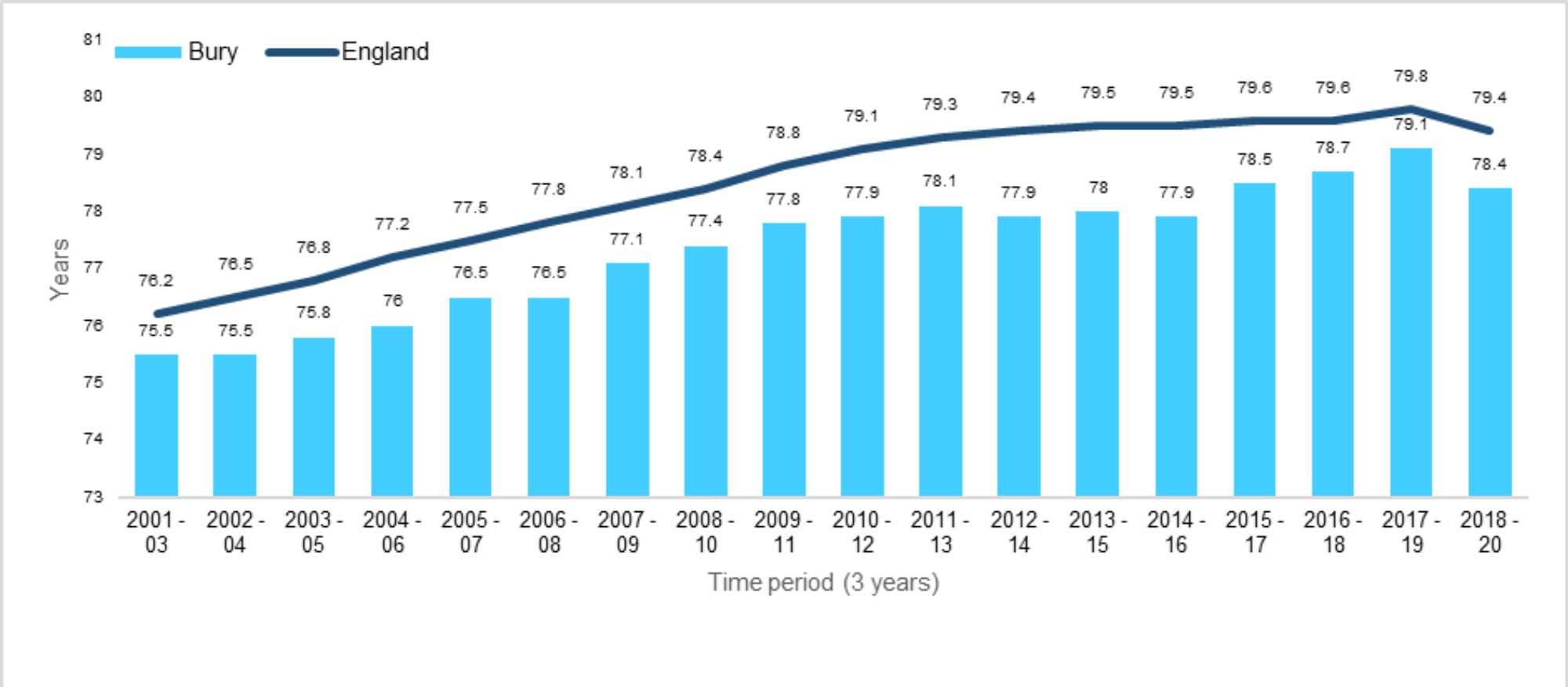 To download a copy of this chart, please left click the button below or use the 'Related Files' section located at the bottom of the page.
To download a copy of this chart, please left click the button below or use the 'Related Files' section located at the bottom of the page.
Life expectancy at birth – Female (all ages)
Figure 2 compares the female life expectancy in Bury to the observed female trend in England from the period 2001-03 to 2018-20. Female life expectancy in Bury has been consistently lower than the national average for England (statistically significant) over the observed time period, with Bury's female life expectancy ranging from 79.9 years in 2001-03 to 82 years in 2018-20. The national average, on the other hand, ranged from 80.7 years to 83.1 years over the same time period. Although life expectancy in females has been increasing in Bury and England over this time, the increase in England has been at a higher rate. Compared with Bury’s statistical neighbours, Bury has the 8th highest female life expectancy for the period 2018-20 in its group of 16 similar local authorities with the highest female LE in Swindon of 83.6 years and the lowest in Oldham of 80.5 years (PHOF, 2020).
The gap between female life expectancy in Bury and England has not been consistent over time. In the early 2000s, the gap was relatively small, at around 0.8-0.9 years. But from around 2009-10 onwards, the gap started to widen, reaching a peak of 1.9 years in 2010-12. Since then, the gap has been decreasing gradually, and in 2018-20 it was 1.1 years.
Figure 2: Life expectancy at birth - Female (3 year range, all ages) in Bury compared with England 2001-03 to 2018-20
-
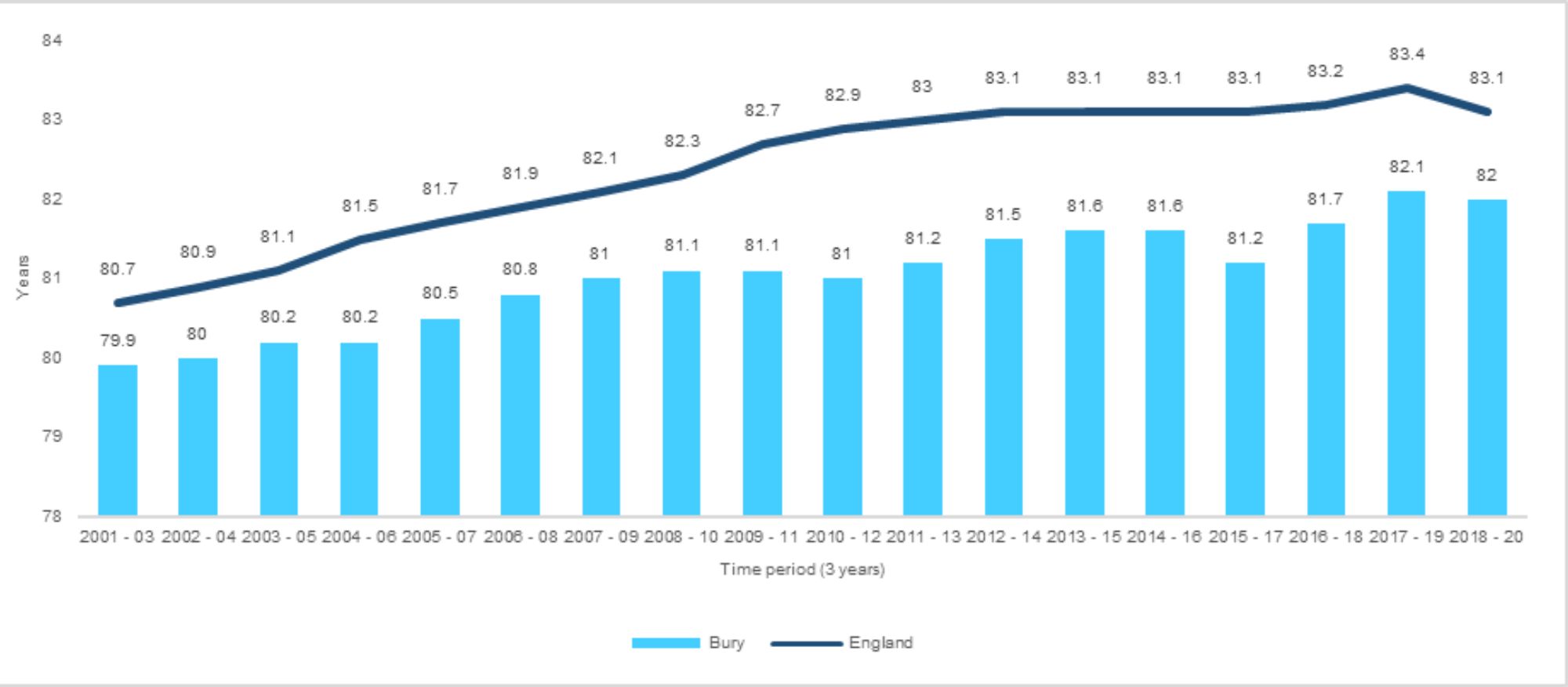 To download a copy of this chart, please left click the button below or use the 'Related Files' section located at the bottom of the page.
To download a copy of this chart, please left click the button below or use the 'Related Files' section located at the bottom of the page.
It is worth examining the causes of the slow rise in LE in Bury and England around 2011-13 and the decline in LE observed in 2018-2020 (more pronounced for males in Bury).
Although there is limited evidence-base at Bury level, the slow rise in LE in England after the sharp gains from 1990s have been hotly debated. A review conducted by Public Health England (PHE) identified a number of factors that contributed to the slowing of life expectancy gains up until 2017. These factors include increasing numbers of older people vulnerable to influenza and other winter risks; slowing improvements in mortality from heart disease and stroke; widening inequalities; and rising death rates from accidental poisoning among younger adults (mainly due to drug misuse). It was noted that the slowdown affected most of the population at a time when health and social care services were facing unprecedented financial pressures and rising demand (HM Government, 2018). Other academic studies have linked the stall in increasing life expectancy and widening of life expectancy gaps to reductions in public spending, both in the UK and overseas (McCartney et al, 2022; Walsh et al, 2022; Alexiou et al, 2021)
The decline in LE observed in 2018-2020 appears to largely impact males in both Bury and England. In Western Europe, the COVID-19 pandemic triggered significant mortality increases in 2020 not seen since World War II. A recent study quantified the impact of COVID-19 through LE in 29 countries examining data from 2015-20 and concluded that males experienced larger life expectancy declines than females across most of the 29 countries. Most life expectancy reductions across different countries were attributable to official Covid deaths (Aburto et al, 2022)
Variations in life expectancy at birth by small geographical areas
Examining variations in life expectancy by small geographic areas can provide policymakers, public health officials, and community leaders with a valuable tool for identifying areas of need and targeting interventions and resources to improve health outcomes and reduce health disparities within a local area.
Local health profiles in fingertips provides LE data at ward and Middle layer Super Output Areas (MSOA) levels to examine these variations for both males and females. Life expectancy figures are presented as 5 years pooled data for males and females.
Bury has 17 wards, which are the primary unit of English electoral geography for civil parishes, borough and district councils and 26 MSOAs. Middle layer Super Output Areas are comprised of between 2,000 and 6,000 households and have a usually resident population between 5,000 and 15,000 persons. MSOAs fit within local authorities.
Variations in male life expectancy at birth in Bury by geographical areas
Life expectancy at birth for males, (upper age band 90 and over) pooled over 5 years from 2016-20 in Bury is one year lower (79 years) than England (80 years).
Male life expectancy at birth – Bury wards
Male life expectancy at birth ranges from the lowest LE in Moorside (73.9 years) and East (74.6 years) to the highest LE in Ramsbottom (81.2) and Pilkington Park (81.7 years).
Figure 3: Life expectancy at birth, (upper age band 90 and over) (Male) across 17 wards in Bury (5 years pooled data 2016-20)
-
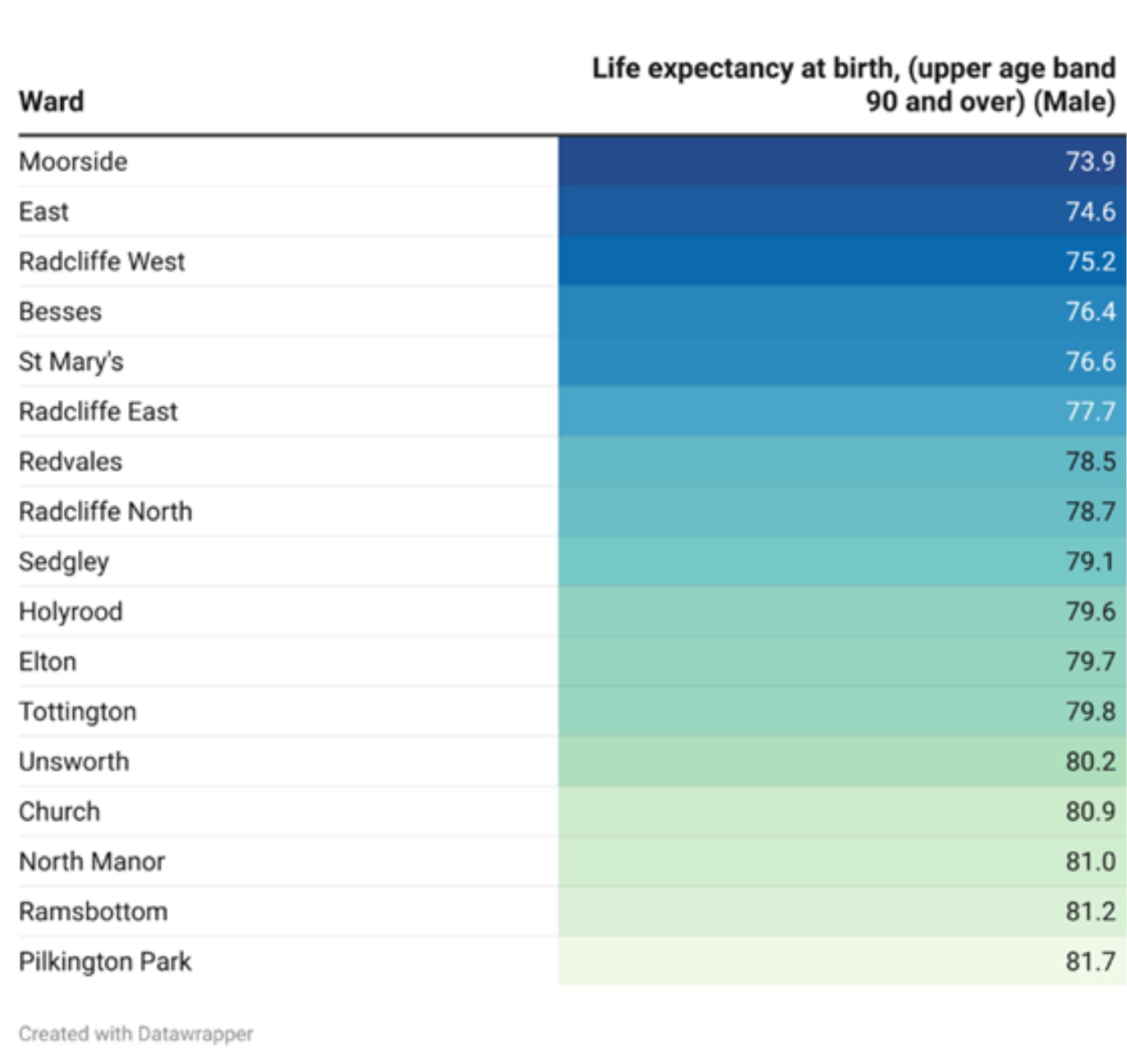 To download a copy of this chart, please left click the button below or use the 'Related Files' section located at the bottom of the page.
To download a copy of this chart, please left click the button below or use the 'Related Files' section located at the bottom of the page.
Male life expectancy at birth – Bury MSOAs
There are wide variations in male LE at birth in across MSOAs in Bury, with the lowest LE at birth for males in Buckley Wells and Fishpool at 71.2 years followed by Prestwich Central at 72.6 and the highest LE for males in Outwood Gate (83.2 years) and Sedgley Park (83.5 years). Buckley Wells and Fishpool and Prestwich Central are the most deprived MSOAs in Bury (Figure 4).
Figure 4: Life expectancy at birth, (upper age band 90 and over) (Male) across 26 MSOAs in Bury (5 years pooled data 2016-20)
-
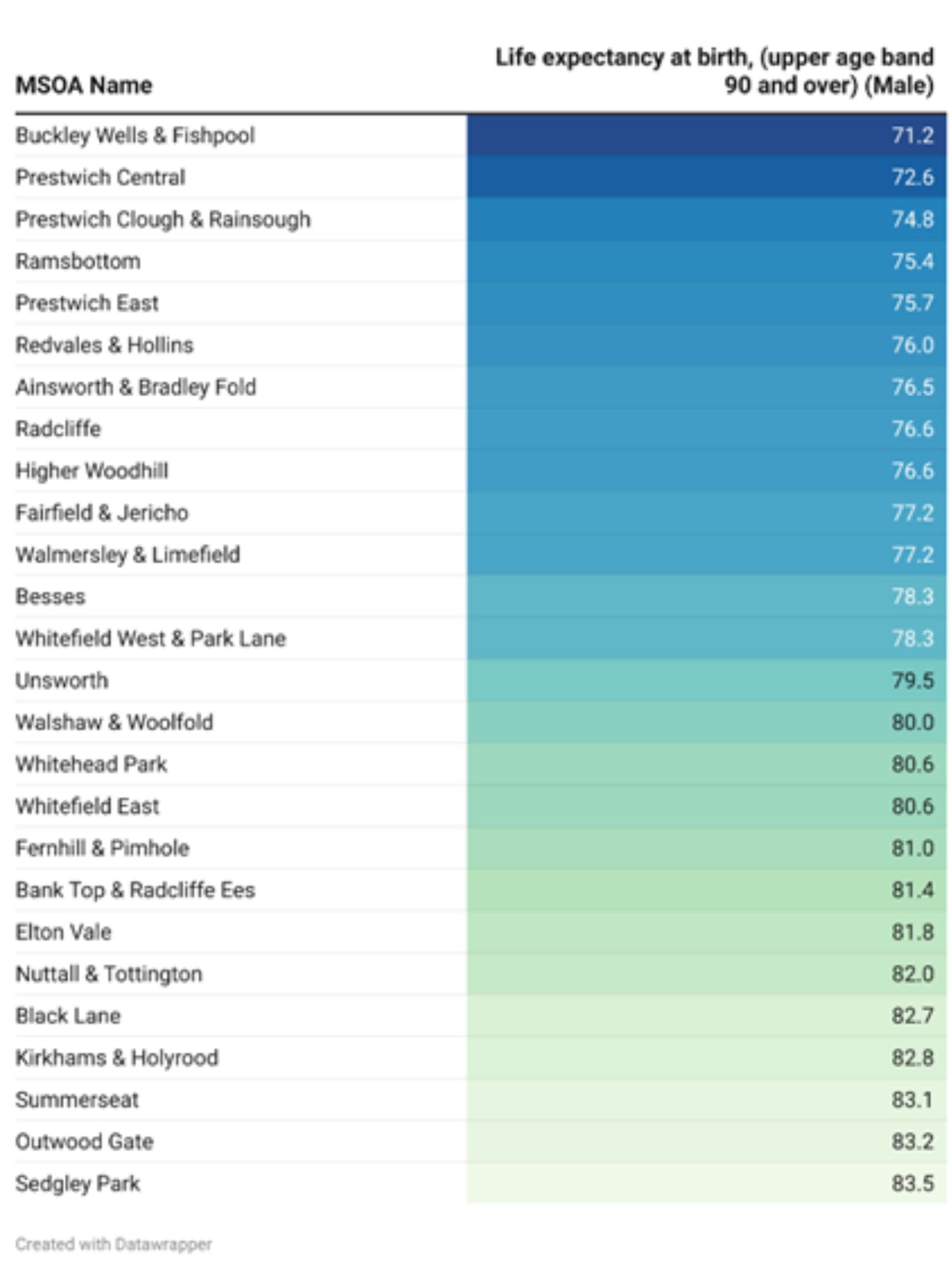 To download a copy of this table, please left click the button below or use the 'Related Files' section located at the bottom of the page.
To download a copy of this table, please left click the button below or use the 'Related Files' section located at the bottom of the page.
Variations in female life expectancy at birth in Bury by geographical areas
Life expectancy at birth for females, (upper age band 90 and over) pooled over 5 years from 2016-20 in Bury is 1.5 years lower (81.7 years) than England (83.2 years).
Female life expectancy at birth – Bury wards
Female life expectancy at birth in Bury ranges from the lowest LE in Moorside (77.9 years) and Radcliffe West (79 years) to the highest LE in Ramsbottom (84.7 years) and North Manor (85 years) (Figure 5).
Figure 5: Life expectancy at birth, (upper age band 90 and over) (Female) across 17 wards in Bury (5 years pooled data 2016-20)
-
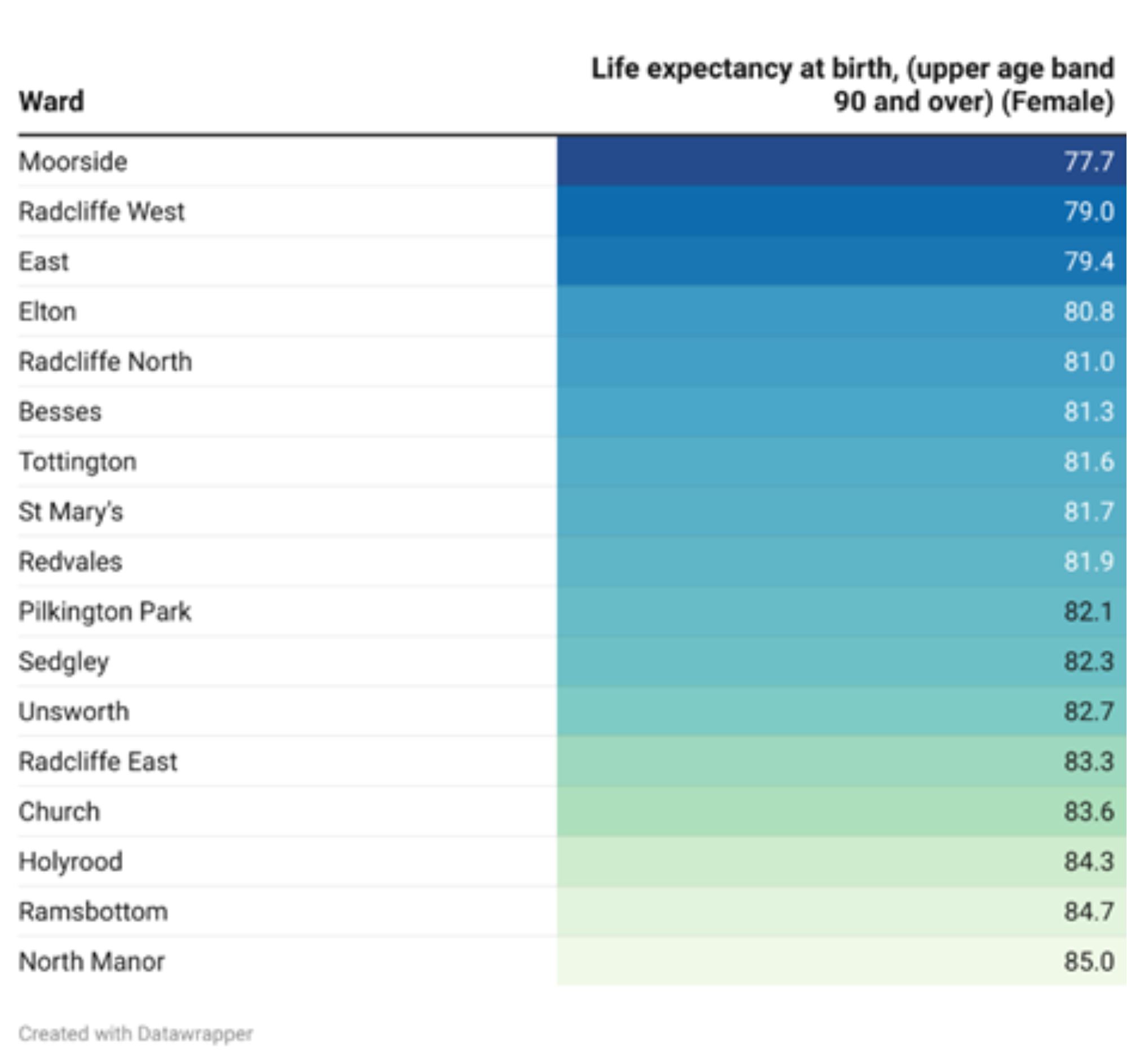 To download a copy of this chart, please left click the button below or use the 'Related Files' section located at the bottom of the page.
To download a copy of this chart, please left click the button below or use the 'Related Files' section located at the bottom of the page.
Female life expectancy at birth – Bury MSOAs
There are wide variations in female LE in Bury ranging from the lowest LE at birth in Buckley Wells and Fishpool (75.8 years) and Prestwich Central at 73 and the highest LE in Outwood Gate (85.7 years) and Summerseat (86.2 years) (Figure 6).
Figure 6: Life expectancy at birth, (upper age band 90 and over) (Female) across 26 MSOAs in Bury (5 years pooled data 2016-20)
-
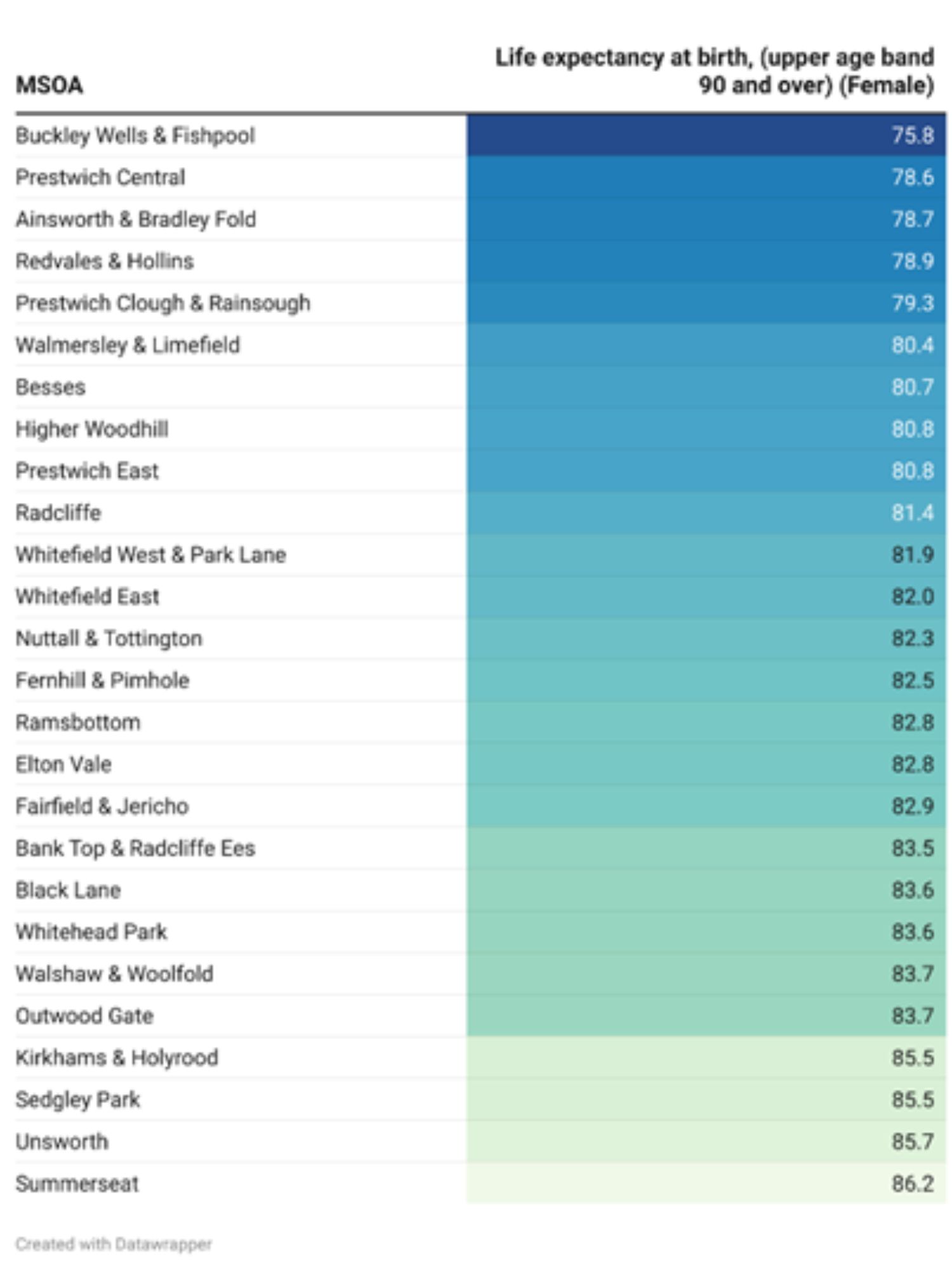 To download a copy of this table, please left click the button below or use the 'Related Files' section located at the bottom of the page.
To download a copy of this table, please left click the button below or use the 'Related Files' section located at the bottom of the page.
Inequality in life expectancy at birth
Life expectancy is a key measure of a population’s health status. Inequality in life expectancy is therefore one of the foremost measures of health inequality. An areas overall level of deprivation correlates closely with its life expectancy. People residing in affluent areas have a significantly longer life expectancy than those residing in deprived areas (Kings Fund, 2022). For Bury, this can be demonstrated using a "slope index of life expectancy inequality” indicating the disparity in life expectancy between the most deprived and least deprived population groups. The steepness of the slope depicts the deprivation related inequities in life expectancy. The line would be horizontal if there were no inequities.
Inequality in life expectancy at birth for males in Bury has remained relatively stable increasing from 9.3 years in 2001-03 to 9.7 years in 2018-20 (PHOF, 2020). However, inequality in LE at birth in females in Bury has increased from 6.3 years in 2001-03 to 7.9 years in 2018-20 (PHOF, 2020).
male
Figure 7 below presents life expectancy at birth for males across deprivation deciles in Bury for the three year period 2018-20, with decile 1 being the most deprived and decile 10 being the least deprived. Males born in the most deprived areas (decile 1) have a life expectancy of 71.3 years, which is the lowest among all the deprivation deciles. As the levels of deprivation decreases, the life expectancy increases. The highest life expectancy is observed in males in the least deprived areas (decile 10), with a life expectancy of 82.9 years.
The data suggests a deprivation gradient with individuals born in more deprived areas having lower life expectancies compared to those born in less deprived areas, but with a disproportionate effect seen in the most deprived decile.
Figure 7: Life expectancy at birth – Male (3 year range, all ages) in Bury by levels of deprivation 2018-20
-
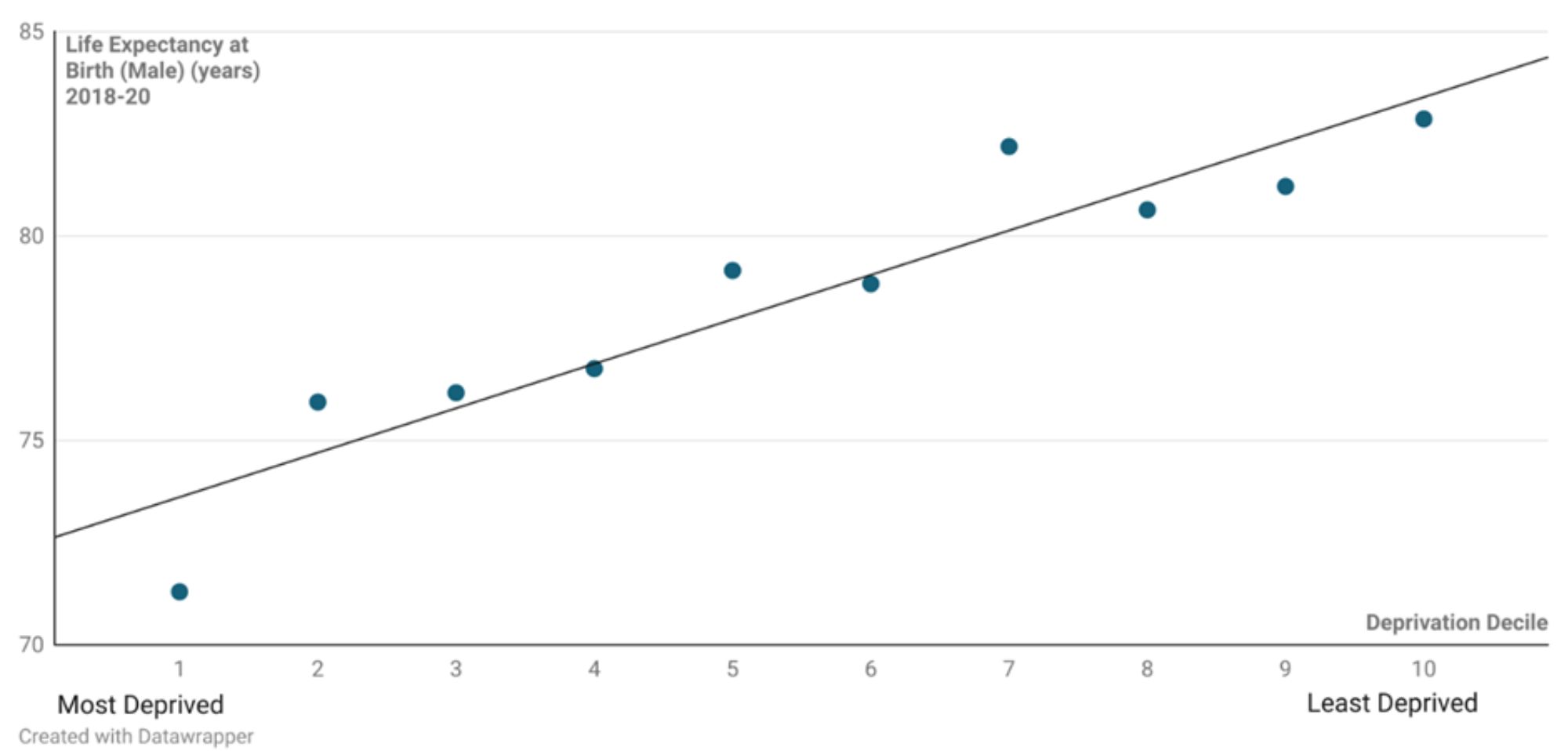 To download a copy of this chart, please left click the button below or use the 'Related Files' section located at the bottom of the page.
To download a copy of this chart, please left click the button below or use the 'Related Files' section located at the bottom of the page.
female
Females born in the most deprived areas (decile 1) have a life expectancy of 76.5 years (5.2 years higher than males in the most deprived decile in Bury), which is the lowest among all the deprivation deciles. As the levels of deprivation decreases, the life expectancy increases. The highest life expectancy is observed in females in the least deprived areas (decile 10), with a life expectancy of 85.6 years (2.7 years higher than the LE for males in the least deprived decile in Bury). The data suggests a deprivation gradient with individuals born in more deprived areas having lower life expectancies compared to those born in less deprived areas, but with a disproportionate effect seen in the most deprived decile (Figure 8).
Figure 8: Life expectancy at birth – Female (3 year range, all ages) in Bury by levels of deprivation
-
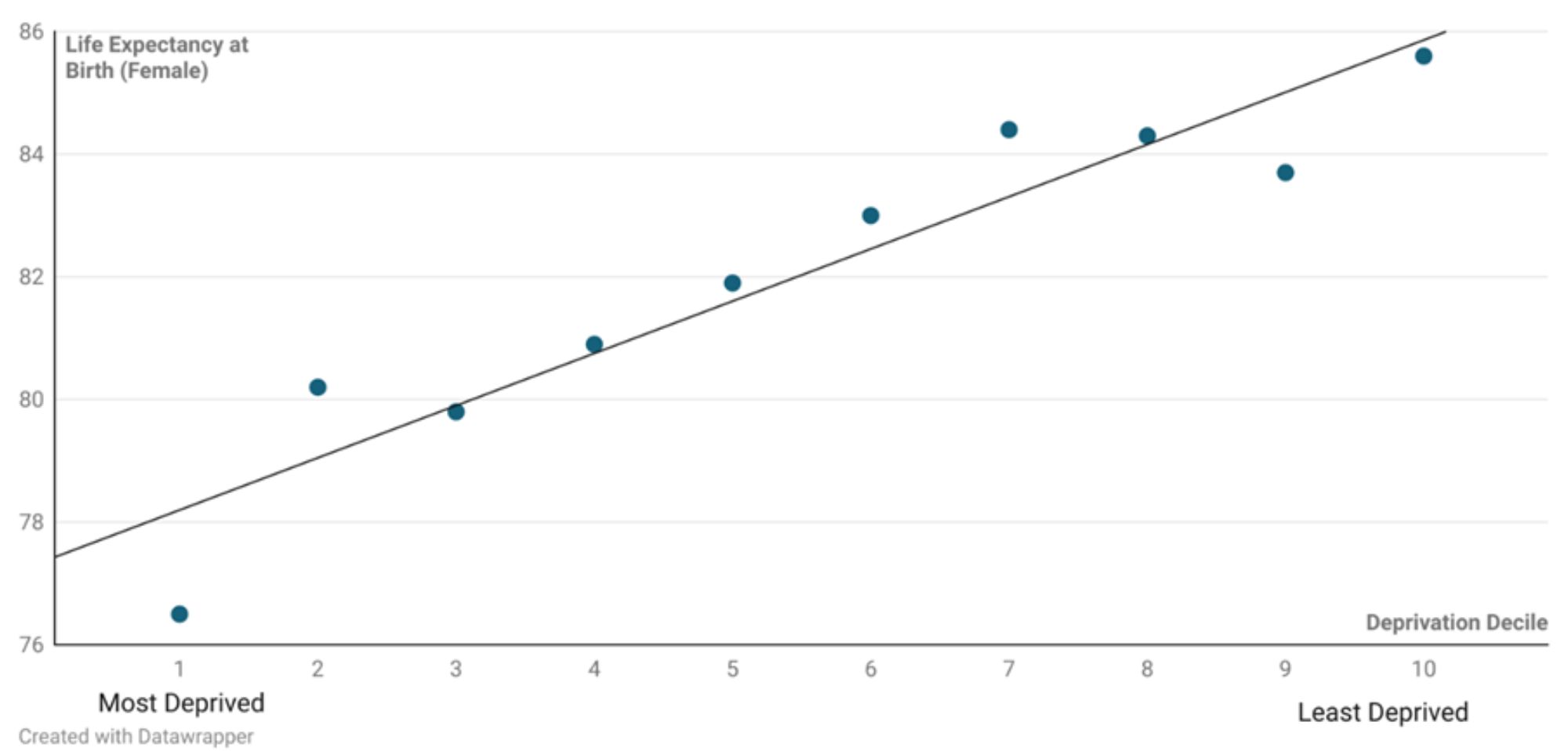 To download a copy of this chart, please left click the button below or use the 'Related Files' section located at the bottom of the page.
To download a copy of this chart, please left click the button below or use the 'Related Files' section located at the bottom of the page.
Gap in Life expectancy
Table 1 below presents the life expectancy gap between the most deprived and least deprived deciles in two different three-year periods, 2011-2013 and 2018-2020. The data is broken down by sex, with separate statistics for males and females. Deprivation deciles are used to examine the experience of individuals, families or communities in terms of the level of deprivation of the area in which they live.
For males, in the 2011-13 period, the life expectancy for the most deprived decile was 70.5 years, while for the least deprived decile, it was 82.8 years. This represents a gap of 12.3 years between the two areas. In the 2018-20 period, the life expectancy for the most deprived decile was 71.3 years and for the least deprived decile was 82.9 years. This represents a slightly reduced gap of 11.6 years.
For females, in the 2011-13 period, the life expectancy for the most deprived decile was 76.3 years and for the least deprived decile, LE was 85.7 years. This represents a gap of 9.4 years between the two areas. In the 2018-20 period, the life expectancy for the most deprived areas was 76.5 years, while for the least deprived areas, it was 85.6 years. This represents a slightly reduced gap of 9.1 years.
Overall, the data shows that there is a significant gap in life expectancy between the most deprived and least deprived areas, with the gap being more pronounced for males than for females. However, the gap has slightly decreased over time for both sexes.
Table 1: Gap in LE between the most and least deprived deciles in Bury for the period 2011-13 and 2018-20 by sex
-
 To download a copy of this table, please left click the button below or use the 'Related Files' section located at the bottom of the page.
To download a copy of this table, please left click the button below or use the 'Related Files' section located at the bottom of the page.
Healthy Life Expectancy at Birth
Healthy life expectancy (HLE) at birth is a statistical measure of the number of years an individual is expected to live in good health, without significant illness and disability. This measure considers contemporary mortality rates and prevalence of self-reported good health, that is the rates of deaths and illness and provides a more comprehensive measure of population health than life expectancy alone.
‘Good health’ is a self-reported, subjective measure of health. Evidence suggests that it shows consistent association with more objective measures of health, but that inequalities in self-reported good health may underestimate more objective measures (Davillas et al, 2017). This could be because people get their idea of what counts as ‘good health’ from the health of people they see around them. Because it relies on self-reported health measured through surveys, data on healthy life expectancy are not available for smaller geographic areas or other small populations. This means local data on inequalities in healthy life expectancy are not available.
This measure estimates the average number of years a new-born baby would live in good general health if he or she experienced the age-specific mortality rates and prevalence of good health for a specific location and time period throughout his or her lifetime. Deaths from all causes, midyear population estimates, and self-reported general health status are used to calculate figures based on three years of aggregated data. HLE figures reflect the prevalence of good health and mortality among those living in a geographical area during each time period, rather than what those born in the geographical area will experience throughout their lives. Since the health prevalence and mortality rates of the area are likely to change in the future and because many of those born in the area will live elsewhere for at least a portion of their lives, the figures do not accurately reflect the number of years a baby born in the area could expect to live in good general health.
HLE for males in Bury has increased from 60.9 years in 2009-2011 to 63.4 years in 2018-2020, while it has decreased slightly for females (62.6 in 2009-11 to 62.2 years). Male HLE peaked in 2018-20 at 63.4 years, while female HLE peaked in 2015-17 at 63.8. From 2009-2011 to 2016-2018, females had a slightly higher healthy life expectancy than males (except for the period 2012-2014). However, in the two most recent data points (2017-2019 and 2018-2020), HLE was higher in males than in females in Bury (63.6 and 63.4 years vs 61.2 and 62.2 years respectively).
It is likely that a combination of demographic, behavioural and health-related factors contributed to the fluctuations in HLE observed in Bury and England. It is also possible that the COVID-19 pandemic and the cost-of-living crisis will have an impact on healthy life expectancy in Bury and England. While it may be too early to fully assess the impact of the pandemic on HLE, it is likely that the pandemic has led to an increase in mortality and morbidity, especially among our older and vulnerable populations. The COVID-19 pandemic may also have indirect impacts on HLE, such as disruptions to healthcare services, changes in behavioural risk factors due to social distancing and lockdowns, and economic hardships that can impact access to healthcare, healthy food options and consumption of alcohol, and physical activity. It is important to monitor and analyse the impact of the COVID-19 pandemic on HLE in Bury and England in the coming years, as this will provide valuable insights into the overall health status and wellbeing of the population.
Healthy life expectancy at birth – Male (Years)
Looking at the data in Figure 9, we can see that the trend for healthy life expectancy (HLE) at birth in Bury males is relatively stable from 2009-11 to 2011-13, with HLE ranging between 60.9 and 61.7 years. However, there is a decline in HLE in Bury from 2013-15 to 2014-16, with HLE decreasing from 60.5 years to 58.5 years. After that, there is an improvement in HLE in Bury, with the HLE increasing to 60.4 years in 2016-18 and further to 63.4 years in 2018-20. Bury has the 2nd highest HLE at birth for males in its group of similar local authorities for the period 2018-20, with the highest HLE at birth for males in Stockport (65.1 years) and lowest in Oldham (56.6 years) (PHOF, 2020).
In contrast, the trend for HLE at birth in England for males shows a gradual increase from 63 years in 2009-11 to 63.4 years in 2012-14 and then remained steady until 2016-2018 with HLE at 63.4 years. In the last two periods, HLE at birth in males slightly declined to 63.2 years in 2017-19 and 63.1 years in 2018-20.
Figure 9: Healthy life expectancy at birth - Male (years) in Bury compared with England 2009-11 to 2018-20
-
-in-Bury-compared-with-England-2009-11-to-2018-20-.jpg) To download a copy of this table, please left click the button below or use the 'Related Files' section located at the bottom of the page.
To download a copy of this table, please left click the button below or use the 'Related Files' section located at the bottom of the page.
The gap between the HLE in Bury and England has fluctuated throughout the years. Between 2009-11 and 2013-15, the gap remained relatively stable ranging from 2.1 years in 2009-11 to 2.9 years in 2013-15. Between 2014-2016 and 2016-18, the gap widened, with a peak of 4.8 years in 2014-16. HLE in Bury males remained lower than England average (statistically significant) from 2009-11 to 2016-18. In the last two time periods (2017-19 and 2018-20) HLE in Bury was similar to England average. The gap between Bury and the England average life expectancy narrowed, with the difference being only -0.3 years in the most recent period of 2018-20 with Bury having HLE in males at birth (63.4 years) than the England average (63.1 years).
Healthy life expectancy at birth – Female (Years)
Figure 10 compares the female healthy life expectancy in Bury to the observed female trend in England from the period 2009-11 to 2018-20. Female healthy life expectancy in Bury has been consistently lower than the national average for England over the observed time period, with Bury's female life expectancy slightly declining from 62.6 years in 2009-11 to 62.2 years in 2018-20 (statistically similar to England average). The national average for England has remained stable with a very slight decline from 64 years in 2009-11 to 63.9 years in 2018-20.
From 2009 to 2014, the HLE at birth for Bury females decreased consistently, falling from 62.6 years in 2009-11 to 60.4 years in 2012-14. This was followed by a slight increase to 62 years in 2013-2015, which continued in 2015-2017, when the HLE reached 63.8 years. Another decline followed until 2017-2019, when the HLE was 61.4%. However, healthy life expectancy increased in 2018-2020, bringing the value back up to 62.2 years. Bury has the 5th highest HLE at birth for females in its group of similar local authorities for the period 2018-20, with the highest HLE at birth for females in Medway (63.6 years) and lowest in Doncaster (56.1 years) (PHOF, 2020).
In contrast, the trend in healthy life expectancy at Birth in females in England appears to be relatively stable from 2009-11 to 2018-20, with a slight decrease from 64 years in 2009-2010 to 63.5 years in 2017-2019, before returning to 63.9 years in 2018-2020.
Figure 10: Healthy life expectancy at birth - Female (years) in Bury compared with England 2009-11 to 2018-20
-
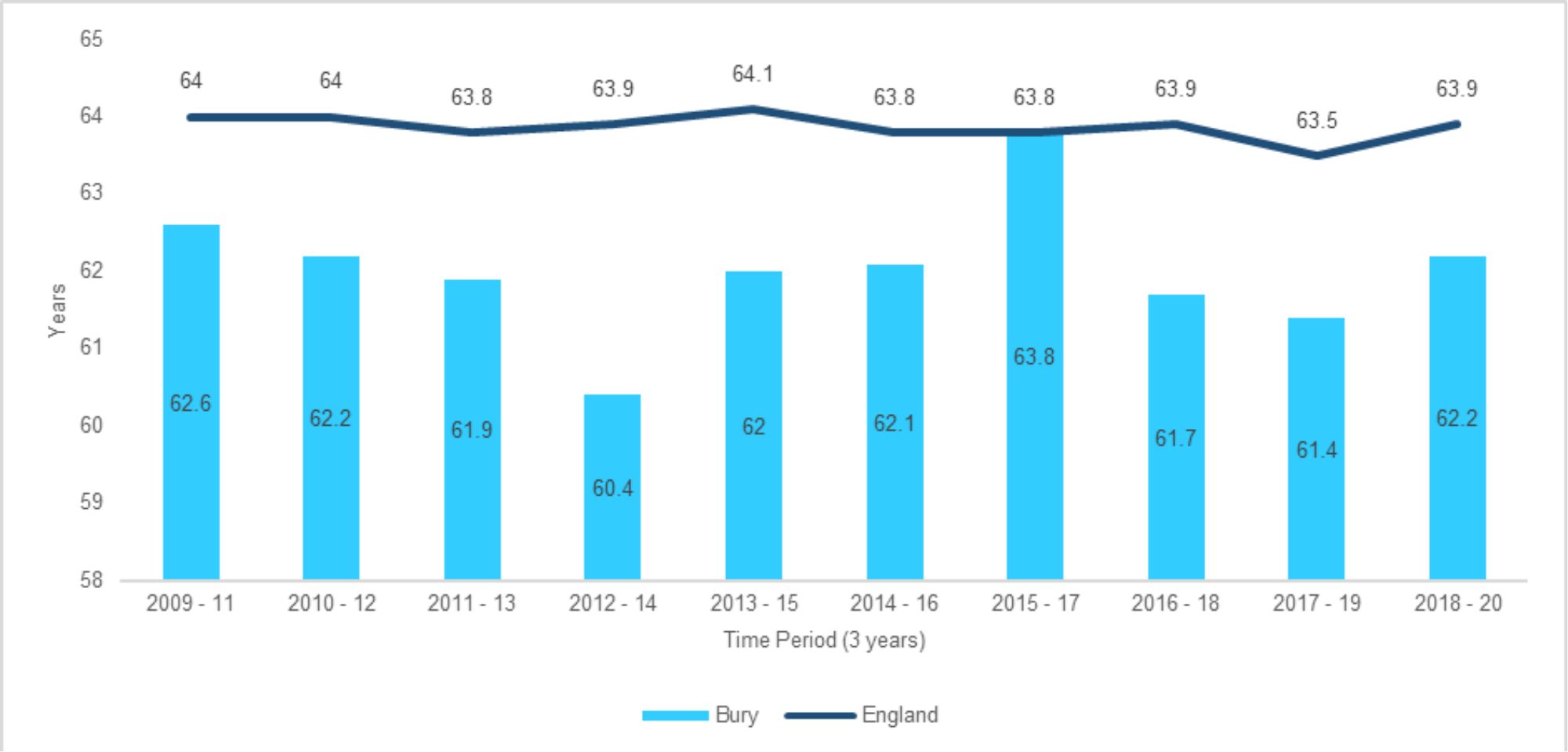 To download a copy of this chart, please left click the button below or use the 'Related Files' section located at the bottom of the page.
To download a copy of this chart, please left click the button below or use the 'Related Files' section located at the bottom of the page.
The gap between the Bury and England has varied over the observed time period, with a difference of 1.4 years between Bury and England in 2009-11, increasing to 3.5 years in 2012-14, before narrowing down to 1.7 years in 2014-2016 and disappearing in 2015-2017. However, in 2018-2020, the gap widened again to 2.2 years.
Variations in healthy life expectancy at birth by small geographical areas
Due to lack of data at MSOA and ward levels, we cannot examine the variations in HLE at birth for males and females in Bury
Inequality in healthy life expectancy at birth
The data on inequality in HLE at birth for both males and females cannot be examined as they are not timely, with the most recent data available for the period 2009-2013.
Disability-free life expectancy at birth
Disability-free life expectancy at birth (DFLE) is a key indicator of health status and quality of life of a population considering not only the years of life but also the quality of life. It measures the number of years a person can expect to live without experiencing any disability or limitation in their activities of daily living. This includes both physical and mental impairments that can impact a person's ability to perform daily tasks.
The measure uses a prevalence of individuals without a disability derived from survey responses. It is an estimate of the average number of years a new-born would live without a disability for a specific location and time period if he or she experienced the age-specific mortality rates and disability free prevalence for that location and time period throughout his or her life. Deaths from all causes, mid-year population estimates, and self-reported disability are used to calculate figures based on data compiled over a three-year period. Figures reflect the prevalence of those without a disability and mortality among those living in an area during each time period, not what those born in the area will experience throughout their lives. The figures are not therefore the number of years a baby born in the area could expect to live disability free, both because the prevalence and mortality rates of the area are likely to change in the future and because many of those born in the area will live elsewhere for at least some part of their lives (PHOF, 2023).
Examining data for Bury, DFLE at birth for both males and females increased from 2014-16 to 2017-19 and then slightly declined. Between the periods 2014-16 and 2017-19, disability free life expectancy at birth in males increased from 58.6 years to 60.7 years, while in females it increased from 59.6 years to 61.7 years. DFLE at birth for females in Bury remained consistently higher than males during this period. However, the DFLE for females at birth decreased significantly from 2018-2020 to 59.1 years, which is lower than the DFLE for males at 60.4 years for the same time period. DFLE for both males and females was highest in the period 2017-19, with females having DFLE at birth of 61.7 years and males having a DFLE at birth of 60.7 years.
Disability-free life expectancy at birth – Male (all ages)
Figure 11 compares the DFLE of males in Bury to the trend observed for males in England for the period 2014-16 to 2018-20. DFLE in Bury increased from 58.6 years in 2014-15 to 60.7 years in 2017-19 (remaining below the England average throughout this time period) before decreasing slightly to 60.4 years in 2018-2020 but remaining statistically comparable to the England average. For England, disability-free life expectancy at birth for males remained fairly stable over the same period, from 62.8 years in 2014-2016 to 62.4 years in 2018-2020, with some fluctuations in between. DFLE in Bury for the period 2018-20 is the 6th highest in its group of similar local authorities with the highest male DFLE in Bedford of 65.4 years and the lowest in Rotherham of 56.3 years (PHOF, 2020).
Figure 11: Disability-free life expectancy at birth - male (years) in Bury compared with England 2014-16 to 2018-20
-
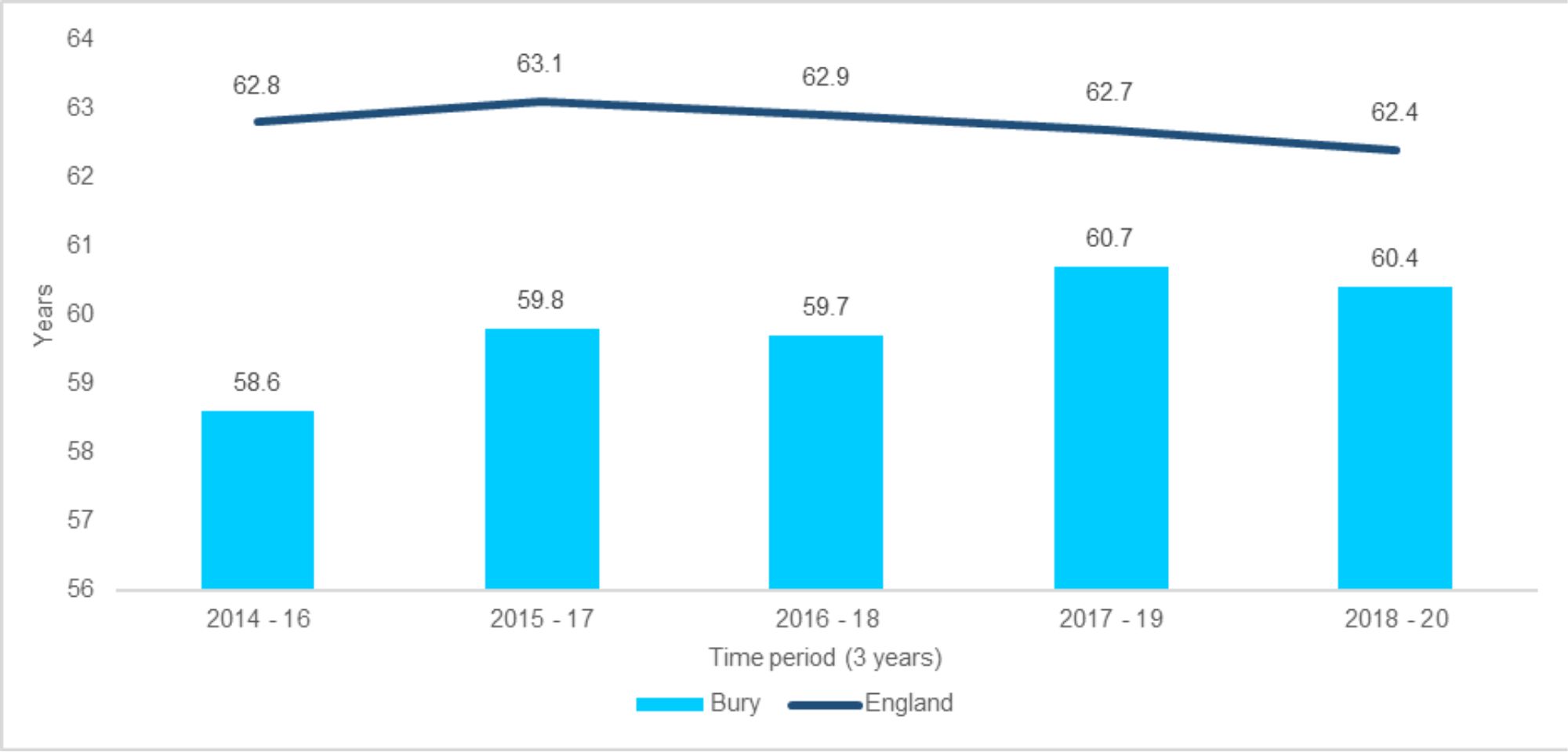 To download a copy of this chart, please left click the button below or use the 'Related Files' section located at the bottom of the page.
To download a copy of this chart, please left click the button below or use the 'Related Files' section located at the bottom of the page.
Disability-free life expectancy at birth – Female (all ages)
Figure 12 compares the DFLE of females in Bury to the trend observed for females in England for the period 2014-16 to 2018-20. DFLE in Bury females increased from 59.6 years in 2014-15 to 61.7 years in 2017-19 before decreasing to 59.1 years in 2018-2020 (statistically comparable to the England average). For England, disability-free life expectancy at birth decreased consistently from 62.3 years in 2014-2016 to 60.9 years in 2018-2020. DFLE for females in Bury for the period 2018-20 is the 7th highest in its group of similar local authorities with the highest female DFLE in Bedford of 61.9 years and the lowest in Doncaster of 53.3 years (PHOF, 2020).
Figure 12: Disability-free life expectancy at birth - Female (years) in Bury compared with England 2014-16 to 2018-20
-
.jpg) To download a copy of this chart, please left click the button below or use the 'Related Files' section located at the bottom of the page.
To download a copy of this chart, please left click the button below or use the 'Related Files' section located at the bottom of the page.
Variations in disability- free life expectancy at birth by small geographical areas
Due to lack of data at MSOA and ward levels, we cannot examine the variations in DFLE at birth for males and females in Bury.
Inequality in disability-free life expectancy at birth
There is a lack of publicly available data on inequality in DFLE at birth for both males and females at Bury and England levels.